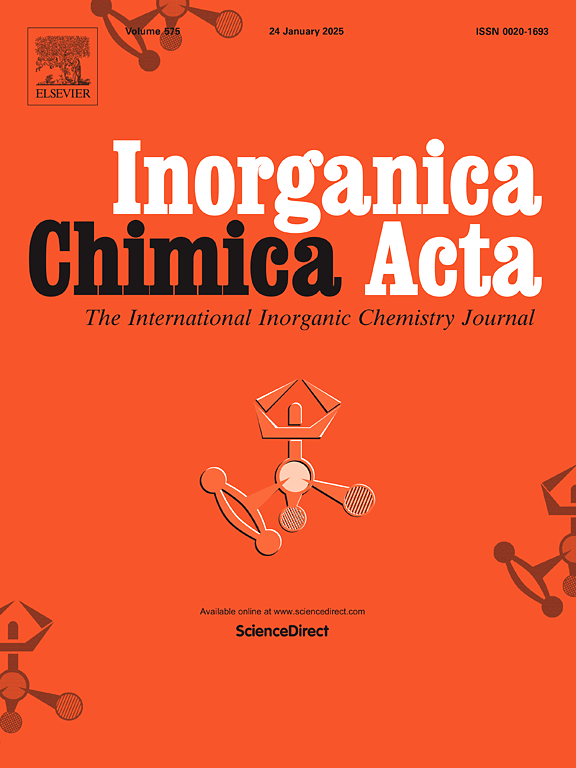偶氮酚酸盐与羧酸盐:通过DFT和分子对接探讨(N, O)-Sn键在二甲基锡(IV)稳定性和抗菌活性方面的优势
IF 3.2
3区 化学
Q2 CHEMISTRY, INORGANIC & NUCLEAR
引用次数: 0
摘要
本文研究了4-(2,4-二羟基苯基偶氮)-苯甲酸的二甲基锡(IV)配合物。主要的焦点是其偶氮酚(N, O)-Sn和羧酸(COO)-Sn键结构异构体的比较稳定性。多核NMR、FT-IR和DFT等分析技术鉴定了溶液中最稳定的5元(N, O)-Sn 4位畸变四面体结构。该复合物对革兰氏阴性菌和革兰氏阳性菌均具有广谱活性,其抑制范围为8 mm(肺炎克雷伯菌)、14 mm(霍乱弧菌)、19.3 mm(金黄色葡萄球菌)和10.7 mm(肺炎链球菌)。相比之下,标准抗生素——庆大霉素和万古霉素——分别对革兰氏阳性和革兰氏阴性细菌无效。分子对接分析表明,该复合物有效结合细菌酶冬眠促进因子和自溶素e的活性位点,导致细菌在应激条件下的生存中断。总的来说,这项研究建立了(N, O)-Sn络合物的稳定性和抗菌潜力,这是一个以前没有研究过的领域。本文章由计算机程序翻译,如有差异,请以英文原文为准。

Azo-phenolate vs. carboxylate: (N, O)-Sn bonding advantage in stability and antibacterial activity of Dimethyltin(IV) explored via DFT and molecular docking
This study presents investigations on a dimethyltin(IV) complex of 4-(2,4-dihydroxy-phenylazo)-benzoic acid. The primary focus is on the comparative stability of its azo-phenolate (N, O)-Sn and carboxylate (COO)-Sn bonded structural isomers. Analytical techniques, including multinuclear NMR, FT-IR, and DFT, identify the 5-membered (N, O)-Sn 4-coordinate distorted tetrahedral structure as the most stable isomer in solution. The complex demonstrates broad-spectrum activity across both Gram-negative and Gram-positive bacteria with inhibition zones of 8 mm (K. pneumoniae), 14 mm (V. cholerae), 19.3 mm (S. aureus), and 10.7 mm (S. pneumoniae). In comparison, standard antibiotics – Gentamycin and Vancomycin- are inactive against Gram-positive and Gram-negative bacteria, respectively. Molecular docking analyses reveal that the complex effectively binds to the active sites of bacterial enzymes Hibernation-Promoting Factor and Autolysin E. This leads to the disruption of bacterial survival under stress. Overall, this research establishes the stability and antibacterial potential of (N, O)-Sn complexes—an area not previously investigated.
求助全文
通过发布文献求助,成功后即可免费获取论文全文。
去求助
来源期刊

Inorganica Chimica Acta
化学-无机化学与核化学
CiteScore
6.00
自引率
3.60%
发文量
440
审稿时长
35 days
期刊介绍:
Inorganica Chimica Acta is an established international forum for all aspects of advanced Inorganic Chemistry. Original papers of high scientific level and interest are published in the form of Articles and Reviews.
Topics covered include:
• chemistry of the main group elements and the d- and f-block metals, including the synthesis, characterization and reactivity of coordination, organometallic, biomimetic, supramolecular coordination compounds, including associated computational studies;
• synthesis, physico-chemical properties, applications of molecule-based nano-scaled clusters and nanomaterials designed using the principles of coordination chemistry, as well as coordination polymers (CPs), metal-organic frameworks (MOFs), metal-organic polyhedra (MPOs);
• reaction mechanisms and physico-chemical investigations computational studies of metalloenzymes and their models;
• applications of inorganic compounds, metallodrugs and molecule-based materials.
Papers composed primarily of structural reports will typically not be considered for publication.
 求助内容:
求助内容: 应助结果提醒方式:
应助结果提醒方式:


